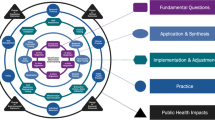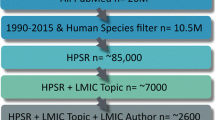Abstract
The objective of this work was to describe and assess the potential impact of the Agency for Healthcare Research and Quality’s, AHRQ’s, children’s health activities. Using AHRQ databases and publications lists and generic search engines, we developed a comprehensive list of AHRQ’s funded children’s health activities (1990–2005) and related publications (1996–2002). We conducted bibliometric analyses and used Stryer’s (2000) approach to categorize their potential impact. We found that AHRQ’s child health portfolio has changed over time with an increase in activities related to patient safety and health information technology, reflecting trends at AHRQ as a whole. Further, AHRQ has contributed a substantial body of new knowledge as a result of its funding for children’s health activities. The bibliometric analysis suggests that AHRQ’s children’s health activities have successfully disseminated research findings and new knowledge through the published literature. Most of the publications present research findings that can be building blocks early in the translation continuum rather than findings that directly inform policy or change clinical practice. Through its funding of children’s health activities, AHRQ has contributed new knowledge that has been disseminated effectively in the published literature. However, while AHRQ has successfully engaged the child health services research community, efforts to broaden into policy, practice and patient arenas have been less successful.

Similar content being viewed by others
References
Seid, M., Schultz, D., McClure, J., & Stoto, M. A. (2006). Evaluation of AHRQ’s children’s health activities. WR-429-AHRQ. Santa Monica, CA: RAND Corporation.
Agency for Healthcare Research and Quality. (2007). Budget estimates for appropriations committees, fiscal year 2008: Performance budget submission for congressional justification. Retrieved June 12, 2007, from http://www.ahrq.gov/about/cj2008/cjweb08.htm.
Agency for Healthcare Research and Quality. (1999). Agency for healthcare research and quality: Reauthorization fact sheet. Retrieved June 12, 2007, from http://www.ahrq.gov/about/ahrqfact.htm.
Forrest, C. B., Simpson, L., & Clancy, C. (1997). Child health services research: Challenges and opportunities. Journal of the American Medical Association, 277(22), 1787–1793. doi:10.1001/jama.277.22.1787.
Bethell, C. D., Read, D., Stein, R. E., Blumberg, S. J., Wells, N., & Newacheck, P. W. (2002). Identifying children with special health care needs: Development and evaluation of a short screening instrument. Ambulatory Pediatrics, 2(1), 38–48. doi:10.1367/1539-4409(2002)002<0038:ICWSHC>2.0.CO;2.
McPherson, M. (2002). Identification of children with special health care needs: A cornerstone to achieving healthy people 2010. Ambulatory Pediatrics, 2(1), 22–23. doi:10.1367/1539-4409(2002)002<0022:IOCWSH>2.0.CO;2.
Child and Adolescent Measurement Initiative, Data Resource Center. (2005). National survey of children with special healthcare needs. Retrieved June 14, 2007, from http://cshcndata.org/DataQuery/DataQueryResults.aspx.
Williams, T. V., Schone, E. M., Archibald, N. D., & Thompson, J. W. (2004). A national assessment of children with special health care needs: Prevalence of special needs and use of health care services among children in the military health care system. Pediatrics, 114(2), 384–393. doi:10.1542/peds.114.2.384.
Whalen, D., Houchens, R., & Elixhauser, A. (2006). 2003 HCUP KIDS’ inpatient database (KID) comparison report. HCUP methods series report # 2006–03. Retrieved June 12, 2007, from http://www.hcup-us.ahrq.gov/reports/methods.jsp.
Darby, C., Crofton, C., & Clancy, C. M. (2006). Consumer assessment of health providers and systems (CAHPS): Evolving to meet stakeholder needs. American Journal of Medical Quality, 21(2), 144–147. doi:10.1177/1062860606286263.
Agency for Healthcare Research and Quality. (2006). Evidence-based practice centers overview. Retrieved June 12, 2007, from http://www.ahrq.gov/clinic/epc/.
Agency for Healthcare Research and Quality. (2004). Child health care quality toolbox. Fact sheet. Retrieved June 12, 2007, from http://www.ahrq.gov/news/chtoolfact.htm.
Academy Health. (Undated). Child health services research meeting. Retrieved June 14, 2007, from http://www.academyhealth.org/conferences/childhealth.htm.
Dougherty, D., & Simpson, L. (2004). Measuring the quality of children’s health care: A prerequisite to action. Pediatrics, 113(1), 185–198.
Homer, C., & the Child Health Business Case Working Group. (2004). Exploring the business case for improving the quality of health care for children. Health Affairs, 23(4), 159–166. doi:10.1377/hlthaff.23.4.159.
Simpson, L., Dougherty, D., Krause, D., Ku, C. M., & Perrin, J. M. (2007). Measuring children’s health care quality. American Journal of Medical Quality, 3(22), 80–84. doi:10.1177/1062860606298549.
Agency for Healthcare Research and Quality. (2007). Children’s health advisory group (CHAG). Retrieved June 12, 2007, from http://www.ahrq.gov/child/chagmssn.htm.
Stryer, D., Tunis, S., Hubbard, H., & Clancy, C. (2000). The outcomes of outcomes and effectiveness research: Impacts and lessons from the first decade. Health Services Research, 35(5 Pt 1), 977–993.
Agency for Healthcare Research and Quality. (Undated). Child and adolescent health. Retrieved June 12, 2007, from http://www.ahrq.gov/child.htm.
Agency for Healthcare Research and Quality. (Undated). Grants on-line database. Retrieved June 14, 2007, from http://www.ahrq.gold.gov.
Agency for Health Care Policy and Research. (2005). AHRQ portfolios of research. Retrieved June 12, 2007, from http://www.ahrq.gov/fund/portfolio.htm.
Seid, M., Schultz, D., McClure, J., & Stoto, M. A. (2006). Evaluation of AHRQ’s children’s health activities. WR-429-AHRQ. Santa Monica, CA: RAND Corporation.
Agency for Healthcare Research and Quality. (2004). Closing the quality gap: A critical analysis of quality improvement strategies. Retrieved June 12, 2007, from http://www.ahrq.gov/clinic/epc/qgapfact.htm.
Acknowledgements
This work originated in response to a RFTO from AHRQ and the publication was supported by a contract with the Agency for Healthcare Research and Quality (AHRQ: 282-00-0005_TO19). Its contents are solely the responsibility of the authors and do not necessarily represent the official views of AHRQ. Michael Seid, Michael Stoto and Jane McClure Burstain were employed by the RAND Corporation at the time this work was performed.
Author information
Authors and Affiliations
Corresponding author
Rights and permissions
About this article
Cite this article
Schultz, D., Seid, M., Stoto, M.A. et al. The Agency for Healthcare Research and Quality’s Children’s Health Research Portfolio. Matern Child Health J 14, 1–8 (2010). https://doi.org/10.1007/s10995-008-0423-4
Received:
Accepted:
Published:
Issue Date:
DOI: https://doi.org/10.1007/s10995-008-0423-4




